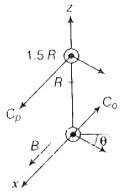Hint: The distance between the centre of the paths should be more than the radius of paths.
Step 1: Since, B is along the x-axis, for a circular orbit the momenta of the two particles are in the y-z plane. Let be the momentum of the electron and positron, respectively. Both traverse a circle of radius R of the opposite sense. Let make an angle with the y-axis, must make the same angle.
The centers of the respective circles must be perpendicular to the momenta and at a distance R. Let the center of the electron be at and of the position at .
The coordinates of ,
The coordinates of ,
The circles of the two shall not overlap if the distance between the two centers is greater than 2R.
Step 2: Let d be the distance between and .
Then,
Step 3: Since d has to be greater than 2R;

